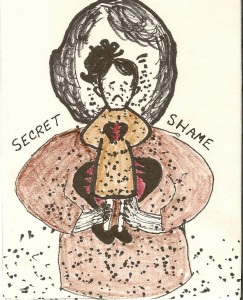 The enemy hides in those shameful, secret places within ourselves. It’s that voice that whispers, “Don’t tell anyone that; let’s keep that to ourselves. It’s too embarrassing for anyone to know.” “Shh! Let this moment go by.”
The enemy hides in those shameful, secret places within ourselves. It’s that voice that whispers, “Don’t tell anyone that; let’s keep that to ourselves. It’s too embarrassing for anyone to know.” “Shh! Let this moment go by.”
Shame is different from guilt. Shame is a sense of worthlessness or inadequacy about aspects of ourselves or in our basic nature. A good way to differentiate guilt and shame is this; we feel guilty for what we do and we feel ashamed of who we are. Shame emphasizes what is wrong with us. It has a much more inward focus, and as such, leads shameful parties to feel poorly about themselves, rather than simply the actions they have taken. The result is often an inward-turning behavior — avoiding others, hiding your face, removing yourself from social situations. Therefore, shame can be problematic, as it is often less constructive than guilt. In fact, shame can lead to withdrawal from social situations and a subsequent defensive, aggressive, and retaliatory behavior, which only exacerbates conflict, rather than alleviating it. Shame is fear-based and drives us to want to hide or protect ourselves from scrutiny. It is hardly ever a helpful or motivating emotion.
We all have shame. It is a basic part of being human. Shame is not all bad, though. It can have great value if we are not overwhelmed by it. There would be no sense of privacy or intimacy without shame. Because shame is an uncomfortable feeling, a person who is not overwhelmed by it can use it to alter his or her behavior. Healthy shame tells us something is wrong in our lives and motivates us to change. Healthy shame is temporary. Excessive shame is not. This shame experience tends to make us feel alone and outside society at the moment it happens, but it has to be acknowledged and dealt with. It may feel as if we are momentarily transparent, showing the world our internal soiled and defective selves, but this is not a terminal wound. Unless we accept this and deal with our shame it accumulates and begins to weigh us down, which is far more dangerous to our overall well-being. Shame makes us want to hide our thoughts and feelings. Keeping shameful secrets only allows them to grow because our imagination runs wild and unchecked by outside information. We may be able to hide our shame from others, but the painful thoughts and feelings remain inside us doing their work. Challenging shame is very difficult, but you don’t have to do it alone. Healing shame is a slow process. The first step is awareness. Because shame exists at the very core of your being and because the shamed person believes her worthlessness is an incontrovertible fact, the shamed person doesn’t recognize shame as the reason she feels worthless. Healing the shame requires patience and the courage to uncover and explore those shaming events which created that core concept.
Healing from shame involves dealing with some old wounds of your past and giving voice to your inner secrets. You have to begin accepting all of your self: your shame-bound feelings, needs and wants; your anger, sadness, fears and joys; your sexuality and your assertiveness. These are the parts that become disconnected out of shame. Journaling, using visualization, dream boards and verbalization can help you reunite with and accept the parts. Finally, the most important thing you can do is choose to love yourself. This is the greatest enemy of shame. You cannot count on unconditional love from anyone except yourself, so say these words out loud and say them often. Even if you don’t believe them yet, say: “I love myself and I accept myself exactly as I am, right now, at this moment.” And just so, the healing has begun.

No comments yet.